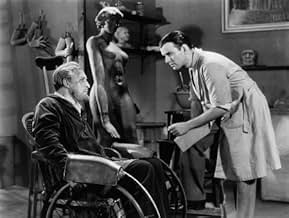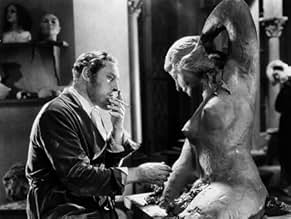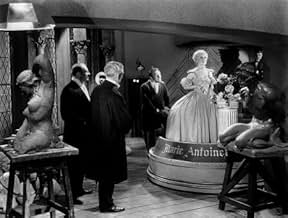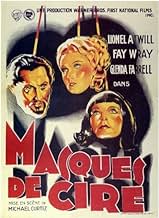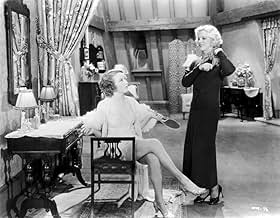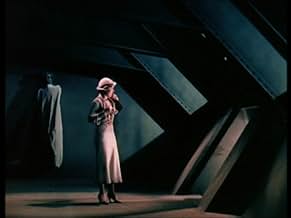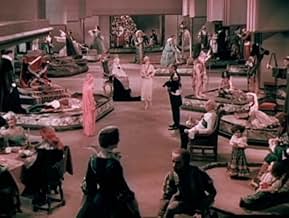AVALIAÇÃO DA IMDb
6,8/10
7,3 mil
SUA AVALIAÇÃO
Em Londres Ivan Igor, um escultor de figuras em cera, luta em vão para impedir que Joe Worth, seu sócio, ponha fogo no museu para receber o dinheiro do seguro.Em Londres Ivan Igor, um escultor de figuras em cera, luta em vão para impedir que Joe Worth, seu sócio, ponha fogo no museu para receber o dinheiro do seguro.Em Londres Ivan Igor, um escultor de figuras em cera, luta em vão para impedir que Joe Worth, seu sócio, ponha fogo no museu para receber o dinheiro do seguro.
- Direção
- Roteiristas
- Artistas
Thomas E. Jackson
- Detective
- (as Thomas Jackson)
Bull Anderson
- Janitor
- (não creditado)
Frank Austin
- Winton's Valet
- (não creditado)
Max Barwyn
- Museum Visitor
- (não creditado)
Wade Boteler
- Ambrose
- (não creditado)
- Direção
- Roteiristas
- Elenco e equipe completos
- Produção, bilheteria e muito mais no IMDbPro
Avaliações em destaque
Classic horror movie directed by Michael Curtiz and starring Lionel Atwill as a deranged sculptor with an "interesting" method of making the statues on display at his wax museum. The last (and best) of the three horror movies Lionel Atwill did with Fay Wray. Atwill is fantastic here and Wray is, as always, delightful. Nice support from Frank McHugh, Gavin Gordon, and Edwin Maxwell, among others. The scene stealer of the movie is Glenda Farrell as the fast-talking reporter heroine. She really has fun with the part. A few years later she would star in the Torchy Blane series and play a character very similar to the one she plays here.
It's a good-looking movie, filmed in two-color Technicolor with nice atmospheric direction from Curtiz. The sets are great, especially Atwill's art deco laboratory. The makeup effects are terrific. It's a juicy Pre-Coder, as evidenced by the gruesome plot and the junkie character played by Arthur Edmund Carewe. Some viewers might be put off by the fact that a large chunk of the middle of the picture is more like a crime story/newspaper movie but I was always entertained, particularly by the back & forth between Farrell and McHugh. So it's not a straight horror movie from beginning to end but, so what, it's still a great film and worth a look. Remade in the '50s as House of Wax with Vincent Price. That version is more well-known than this one but I like rewatching this one more. It's just more fun.
It's a good-looking movie, filmed in two-color Technicolor with nice atmospheric direction from Curtiz. The sets are great, especially Atwill's art deco laboratory. The makeup effects are terrific. It's a juicy Pre-Coder, as evidenced by the gruesome plot and the junkie character played by Arthur Edmund Carewe. Some viewers might be put off by the fact that a large chunk of the middle of the picture is more like a crime story/newspaper movie but I was always entertained, particularly by the back & forth between Farrell and McHugh. So it's not a straight horror movie from beginning to end but, so what, it's still a great film and worth a look. Remade in the '50s as House of Wax with Vincent Price. That version is more well-known than this one but I like rewatching this one more. It's just more fun.
A genuinely frightening film from Michael Curtiz, jack of no trades and master of all. Many of the tricks of classic 1930's horror are here, including the opening scene set in a dark, rainy London street, the long shadows on the wall, lengthy periods of silence, and all timed to perfection. Only the faster-than-the-speed-of-sound dialogue of Glenda Farrell truly lets the film down. But other than that it is a gothic masterpiece, an underrated movie probably due to the fact that it lay undiscovered, thought lost, for over half a century. Far more inventive and imaginative than the majority of horror films made today.
In the early 1930's Jack Warner was under contract to use the Two-strip technicolor process on a Warner Brothers film. Unfortunately, this primitive form of color cinematography had a limited pallet of colors. Everything had an unnatural pastel look. Warner wisely choose a genre not dependent on reality- the horror film. Their first color horror film was DOCTOR X, a wild and macabre who-dunnit complete with scary murders, truly mad doctors and a cannibal. DOCTOR X, released in 1932, was enough of a success, that Warner Brothers reunited it's director, Michael Curtiz, the two leads, Lionel Atwill and Fay Wray, and the two strip Technicolor process for yet another horror film. The new film, simply titled WAX MUSEUM during production was a fast moving creepy chiller that mixed the gloom of Depression era New York with the creepy going-ons of a wax museum. The film begins in 1921. Sculptor Ivan Igor (a bohemian looking Lionel Atwill), so obsessed creating his wax museum, that he ignores that he and his partner, Worth (Edwin Maxwell) are in deep financial trouble. Worth sets fire to the museum to collect on a fire insurance policy. The museum is destroyed, and Igor is left a cripple with useless hands.
Twelve years later, in Manhattan, Igor opens a new wax museum. At the same time, a wisecracking reporter, Florence (Glenda Farrell) tracks a hot case of the corpse of a recently murdered socialite stolen from the morgue. She begins to suspect that creepy wax museum downtown of stealing bodies and posing them as wax statues. What makes things worse, is that her best friend, Ruth (Fay Wray) is dating the most innocent of the questionable wax-workers. THE MYSTERY OF THE WAX MUSEUM is a DVD shelf must-have.
Twelve years later, in Manhattan, Igor opens a new wax museum. At the same time, a wisecracking reporter, Florence (Glenda Farrell) tracks a hot case of the corpse of a recently murdered socialite stolen from the morgue. She begins to suspect that creepy wax museum downtown of stealing bodies and posing them as wax statues. What makes things worse, is that her best friend, Ruth (Fay Wray) is dating the most innocent of the questionable wax-workers. THE MYSTERY OF THE WAX MUSEUM is a DVD shelf must-have.
These days, Mystery of the Wax Museum has become best known for the fact that it was the film that spawned the 1953 classic starring Vincent Price. This is somewhat unfair, however, as although this film isn't a brilliant masterpiece, or even genre classic, it has a right to remembered in it's own right. The film is actually quite daring and inventive for the time when it was made; and despite the fact that nothing too bad is graphically shown, for obvious reasons, some of the imagery on display does actually succeed in being quite disturbing. Take the deformed face of the central character for example; it won't keep you up all night, but considering the time when this was made; the effects are good. The two-strip Technicolor style of the film gives it something of a unique feel; and this again is to it's credit as the film has aged really, really well. The plot line will be familiar to anyone who has seen the Vincent Price version, but here, aside from a museum proprietor that gets his life work melted away in an inferno; we've got a press investigation into the affairs as well.
Lionel Atwill takes the lead role as the unfortunate victim of the flames, and while he's certainly no Vincent Price; he does well with what he's got and helps to create a macabre surrounding around his character, which in turn helps the film in the atmosphere department. Joining him are Glenda Farrell and Fay Wray as the heroine's of the story. Wray plays the girl that the unfortunate artist becomes obsessed with, and Farrell gives a slightly irritating, but very lively performance as a journalist. Both do well with their roles, and although this film isn't exactly an exhibition in acting (unlike Curtiz's masterpiece, Casablanca); the cast do well enough. One thing that is unfortunate for this film is that it's seen as a second feature for the Price version, which will harm what some viewers think of it as the plot elements are very similar to the 1953 film, so it can, at times, feel as though you're simply watching the same film again. However, if viewed as a stand-alone product, Mystery of the Wax Museum represents a solid 30's horror movie and I can see why any horror fan wouldn't enjoy it.
Lionel Atwill takes the lead role as the unfortunate victim of the flames, and while he's certainly no Vincent Price; he does well with what he's got and helps to create a macabre surrounding around his character, which in turn helps the film in the atmosphere department. Joining him are Glenda Farrell and Fay Wray as the heroine's of the story. Wray plays the girl that the unfortunate artist becomes obsessed with, and Farrell gives a slightly irritating, but very lively performance as a journalist. Both do well with their roles, and although this film isn't exactly an exhibition in acting (unlike Curtiz's masterpiece, Casablanca); the cast do well enough. One thing that is unfortunate for this film is that it's seen as a second feature for the Price version, which will harm what some viewers think of it as the plot elements are very similar to the 1953 film, so it can, at times, feel as though you're simply watching the same film again. However, if viewed as a stand-alone product, Mystery of the Wax Museum represents a solid 30's horror movie and I can see why any horror fan wouldn't enjoy it.
Michael Curtiz has over 170 directing credits, including "The Jazz Singer." Of the films on that list which I have seen, this is my favourite. It's filled with some quite amazing dolly and camera work, the story is fun and the acting is solid.
This story has had a long life. This film, was based on a play. In 1953, it was re-made as a Vincent Price vehicle, "House of Wax" in 3-D. And in 2005, it was re-made again as a teen slasher. The premise is solidly creepy.
Glenda Farrell is hilarious as the young journalist. Her energy leaps off the screen. I guess audiences of 1933 needed quite a bit of comic relief to make it through the rest of this.
Lionel Atwill's make-up is fantastic. It's no surprise that it was designed by a Westmore: Hollywood's premiere make-up family.
This was shot in a two-colour Technicolor process which makes the entire film rather distinctive and moody. The fantastic film noir lighting adds to it as well.
If you can find this, it's a definite must-see! There are so many images and ideas borrowed from it in later horror films it's interesting to see their origins.
This story has had a long life. This film, was based on a play. In 1953, it was re-made as a Vincent Price vehicle, "House of Wax" in 3-D. And in 2005, it was re-made again as a teen slasher. The premise is solidly creepy.
Glenda Farrell is hilarious as the young journalist. Her energy leaps off the screen. I guess audiences of 1933 needed quite a bit of comic relief to make it through the rest of this.
Lionel Atwill's make-up is fantastic. It's no surprise that it was designed by a Westmore: Hollywood's premiere make-up family.
This was shot in a two-colour Technicolor process which makes the entire film rather distinctive and moody. The fantastic film noir lighting adds to it as well.
If you can find this, it's a definite must-see! There are so many images and ideas borrowed from it in later horror films it's interesting to see their origins.
Você sabia?
- CuriosidadesThis film was produced before the Production Code. When it was remade 20 years later, as Museu de Cera (1953), all references to drug use were removed, and a character was changed from a junkie to an alcoholic.
- Erros de gravaçãoIvan Igor says that Jean Paul Marat's assassin, Charlotte Corday, was his mistress. This is incorrect; they never had met until she came to his office posing as a courier and quickly stabbed him to death. After her execution a few days later, she was found to be virgo intacta.
- Versões alternativasThis film was shot in two versions. One camera unit shot the film in two-color Technicolor. A second camera unit shot the scenes at the same time in black and white. The black and white version was meant for theaters who could not afford the higher rental cost of the color prints.
Principais escolhas
Faça login para avaliar e ver a lista de recomendações personalizadas
Detalhes
- Data de lançamento
- País de origem
- Idioma
- Também conhecido como
- Mystery of the Wax Museum
- Locações de filme
- Empresa de produção
- Consulte mais créditos da empresa na IMDbPro
- Tempo de duração
- 1 h 17 min(77 min)
- Proporção
- 1.37 : 1
Contribua para esta página
Sugerir uma alteração ou adicionar conteúdo ausente


